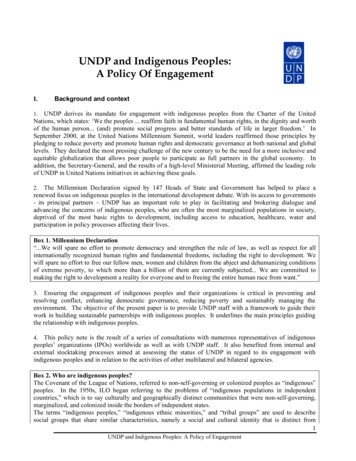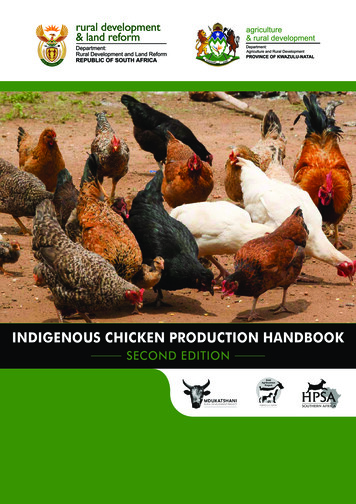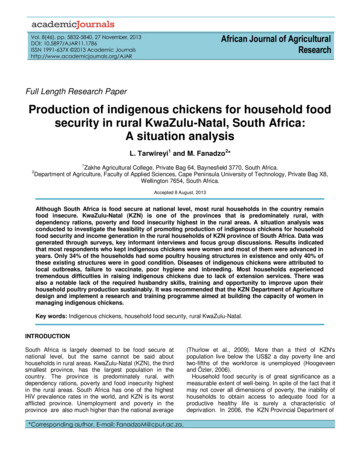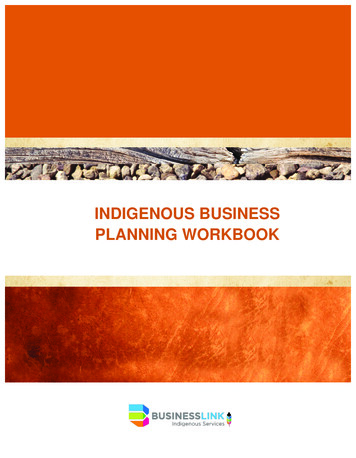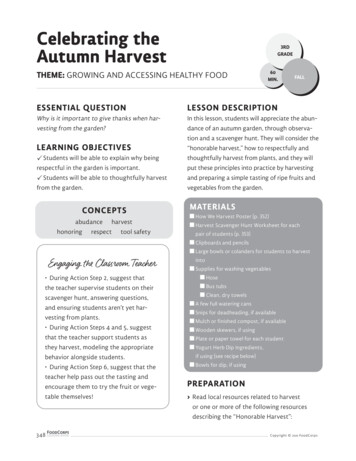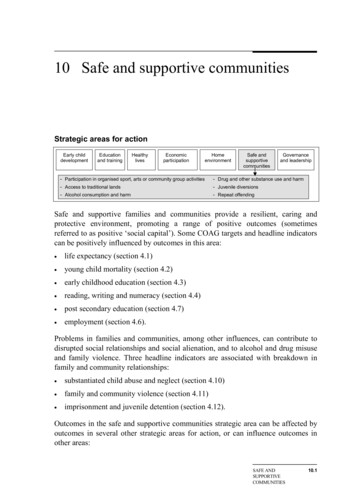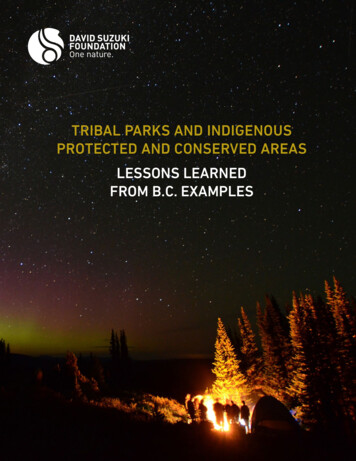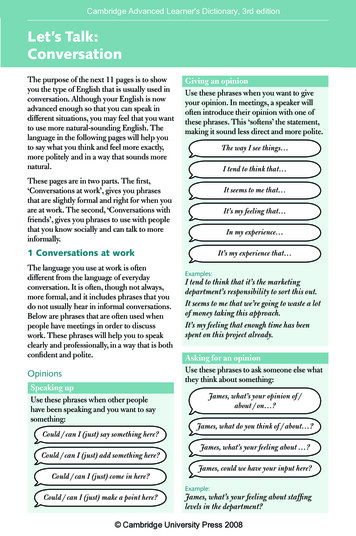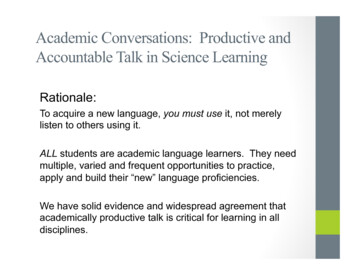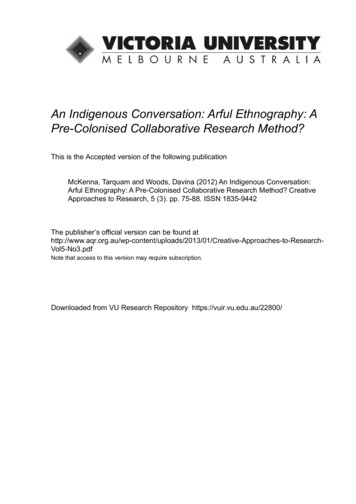
Transcription
An Indigenous Conversation: Arful Ethnography: APre-Colonised Collaborative Research Method?This is the Accepted version of the following publicationMcKenna, Tarquam and Woods, Davina (2012) An Indigenous Conversation:Arful Ethnography: A Pre-Colonised Collaborative Research Method? CreativeApproaches to Research, 5 (3). pp. 75-88. ISSN 1835-9442The publisher’s official version can be found /Creative-Approaches-to-ResearchVol5-No3.pdfNote that access to this version may require subscription.Downloaded from VU Research Repository https://vuir.vu.edu.au/22800/
An Indigenous Conversation - Artful Autoethnography - A Pre-colonizedCollaborative Research Method?ByAssociate Professor Tarquam McKenna & Ms Davina B WoodsSchool of EducationFaculty of Art, Education and Human DevelopmentVictoria UniversityPO Box 14428Melbourne Victoria 8001AustraliaTelephone: 61 3 9919 3371 or 61 3 9919 4000Email: tarquam.mckenna@vu.edu.auKey wordsArtful Auto-ethnographyAuto-ethnographyArtful InquiryIndigenous knowingPoliticised knowingArtful PraxisAuthor biographical notesDr Tarquam McKenna is an Associate Professor at Victoria University,Melbourne, Australia. He has been active as an Arts Psychotherapist for twentyyears and edits the international Australian and New Zealand Journal of ArtTherapy ( ANZJAT). He is past president and an honorary life member ofANZATA - the Australian and New Zealand Art Therapy Association. He iskeenly interested in research methods and especially its applicability toindigenous stories. Tarquam has created and performed playback theater, andhas published widely in the area of gender and sexuality. He is a foundingmember of the Asia Critical Ensemble, which examines social justice and thelegacies of Paulo Freire in particular, and how colonization has impacted onmultiple lives around the world.Davina B. Woods, an Indigenous Australian, is a lecturer and PhD candidate inthe School of Education at Victoria University. The beginning of the 2011academic year saw the first offering of a humanities unit written by Davina forthe second year Bachelor of Education students at Victoria University. Theunit, titled Re-Thinking Australian Studies, has as one of its main objects, tocontribute to the paradigm shift regarding attitudinal and behaviouraldecolonization discussed in this paper.
AbstractIn an earlier chapter McKenna addresses theater research–‘Layers of MeaningResearch and Playback Theater–A Soulful Construct’ as an exploration intothe valuing of what might have been called a ‘personal’ conversation intoresearch, and especially into research using the Arts. In that chapter anexamination of research as “transformative”, and most effective when it hadachieved some level of knowing, was conducted. Of particular interest was thetacit permission given for researchers to see the stories of their co-participants asan inquiry both ‘in action’ and ‘through action’. This chapter contends that artfulpractice as research, must always attend to what has been called ‘interiority’; yet itmoves beyond interiority and soulful research. Although soulful research is stillneeded to realize the value of the inner world and of the matters being researched,here, in the realm of the ‘outside’ world–that world where the artful practiceoccurs–must now become more known to the researcher. This chapter is aconversation and documents the benefits of “artful autoethnography”; itadvances discussion of the uses of autoethnography using art in formulating,evaluating and synthesizing the field of research, especially to ‘decolonize’indigenous peoples around the world. The authors consider the development ofautoethnography, and conduct and report on artful autoethnography as anemerging research practice. They consider the critical issues of identity forindigenous peoples worldwide and ask the reader to enter into a conversationaround how the subjective inner world of interiority and the objective outer worldof ‘space, place and time’ intersect at points ripe for potential research. Theauthors emphasize that the model of artful research presented here alwaysoccupies a politicized space and place–across time–and must consequently workwith an emphasis on its being shared; on a collective collaboration towards researchas artful meaning making.
IntroductionIn this paper, which is a read ‘conversation’, the intention is to take the readerinto the life worlds of its two author-researchers. An academic–TarquamMcKenna–and his colleague, an Australian Indigenous woman–DavinaWoods–set about ‘yarning’1 around art and its role as a vehicle for (re)searchingtheir lives. Never far from their thoughts was the 26 May, 1997, release of theHuman Rights Equal Opportunity Commission’s (HREOC) report, BringingThem Home: National Inquiry into the Separation of Aboriginal and Torres Strait IslanderChildren from Their Families, which included mandated recommendations to thecolonising Australian people. One of these recommendations was that theCommonwealth and State Governments of Australia say ‘sorry’ for the centuriesof shameful and traumatising violations of human rights to which theIndigenous peoples of Australia had been subjected.It took changes in Commonwealth Government leadership and over adecade of vacillation before the then Prime Minister Kevin Rudd stated on the13 February, 2008, that:The time has now come for the nation to turn a new page in Australia'shistory by righting the wrongs of the past and so moving forward withconfidence to the future.And the sky did not fall down.The ConversationTarquam:In Gathering Voices Essays on Playback Theater (Fox, 1999) I wrote a short essay inwhich I somewhat naively set out to qualify the nature of dramatic action, andespecially theater, as a vehicle for research. It was inspired by my work withJonathan Fox, one of the founders of Playback Theater in USA and with acolleague from Australia, Professor John Carroll (Carroll, 1995). The keyelements of ‘transformation’ that are at the centre of that 1990s article and itstitle, “Layers of Meaning Research and Playback Theater–A Soulful Construct”,still hold relevance and meaning for me as a researcher (Conti, Counter & Paul,1991). I’d like to reflect here on working within a model of socially just inquirythat focuses on Indigenous communities. We are eager to ‘push the boundaries’a little on the manner in which research can occur at the intersection of whatare termed artful practice, ethnography and auto-ethnography. These three researchmodes are explored as a ‘model’ and have deliberately been written about as a‘provocation’.Whilst we attend to the notion of research as having a sense ofinteriority, something which I have noted occasionally elsewhere (McKenna,1992, 1992a 1993, 1993a, 1993b 1993c, 1997), we wish to simultaneously drawparticular attention to the work of the paratherapeutic arts, as they havebecome known. This work encompasses the notions that all art forms energize
and, to be art that matters, are socially just in their capacity for transformation. Thisconversation is built on our belief that the arts are now more often used in sucha way that they that are automatically aligned with ‘healing’ or ‘wholeness’ butthat this need not always delivered by an Arts Psychotherapist.I am qualified and registered as an Arts Psychotherapist and my mostrecent work has been mainly focused on the use of the creative arts in aparatherapeutic sense to decolonise Indigenous peoples and validate theirmodels of knowing. Davina Woods is a Kuku-Yalanji and Kuku-Djunganwoman from the Atherton Tablelands, Queensland, Australia and I am, and mymother’s family are, from Tasmania.The study of arts and creativity has been my lifelong passion and thework present here has developed over many years. but came about when Isupervised women drama therapists and arts psychotherapists (Brooke, 2006) intraining for their MA in Art Therapy or Drama Therapy - and when I workedwith storytelling theater in Darwin Australia in 2001.Since writing “Layers of Meaning Research and Playback Theater–ASoulful Construct” in 1999, I have continued to work with women who identifyas Indigenous, and have had many moments of discussion or ‘yarning’ withthem; strands of these conversations are woven through this chapter. This‘yarning’ is a style of first-person reflection used by many Indigenouscommunities and is examined in part in this chapter. Davina and I also used theprocess as the basis of a paper we co-presented at the 2nd Asia Pacific RimCounselling Conference in Hong Kong in June of 2011. That paper ispublished with a focus on psychotherapies, an alignment that will be alluded tobut not fully examined here.Davina:What we hold to is the tenet that when we are ‘yarning’ we are engaged in aquality of encounter that sets out to explain, explore, and open up the qualityand style of our engagement. Ideally, the metaphoric yarn weaves the fabric ofresearcher’s understanding, and the community he or she is in, as acollaborative heuristic-like experience (Douglas & Moustakas, 1985). Theinsights gained into the world and our life views by using yarning can beemployed to attend to trivial or profound matters. But these matters are alwaysimbued with the social, cultural, or historical legacy in which the yarn is takingplace. Attention to the yarn is a form of social and self-dialogical encounter(Moir-Bussy, 2011) which I contend occur simultaneously. Yarning, forTarquam and I was not concerned with the quality of ‘encounter’ espoused byBuber (1973) or Grotowski (1991), but it does have a clear goal of makingknown that which is meaningful alongside the artful and spiritual realms.Tarquam:When we ‘yarn’ and concurrently co-create artworks I believe we are engaged ina process that we, as researchers, should be calling artful auto-ethnography. I wouldlike here to advance discussion of the uses of auto-ethnography employing thearts to formulate, evaluate and synthesize the field of inquiry. As a researcher, Iam very eager to see both theater and the visual arts (especially in Australiawhere Indigenous people were decolonized) employed to redress the inequitiesput upon first nations by the white invaders.
Davina:We can also use art making and this artful auto-ethnographic method to celebratethe Indigenous peoples of the world, of course, but here it is being espoused asa method of inquiry to critique negative experiences encountered in Indigenous communitiesworld wide. The arts have always been a vehicle for communication of meaningand are known ‘naturally’ in many parts of the Indigenous world. Art is ameaning making that is implicit in the daily life of most Indigenouscommunities. Artful ethnography, then, is an emerging research practice that Ithink we should use here as a model of inquiry as we deliberate on creative artspraxis and the critical issues of identity lived out through the worlds ofIndigenous peoples.Tarquam:Davina and I also presented at “Healing our Spirit Worldwide–HOSW” inHawaii in 2010, using art making workshops to develop narratives and stories,and to celebrate the lifeworlds of the Indigenous women and men there. Iwould like here to present the relevance of this research method as it sitsalongside other forms of formalized inquiry. The arts as we know them havealways been seen as a natural way of inquiring and have been acknowledged assuch by many Indigenous communities from time immemorial. So this is notnew. But it is ‘new’ to the world of the contemporary researcher who must askhow we can use this artful ethnography or artful auto-ethnography to contributeparticularly to the sense of psychosocial. A fundamental premise of our yarn, asDavina, stated from the outset: is that we as authors hold to the belief thatIndigenous communities have always and everywhere used artful practice for‘healing’; this was the work of the ‘shaman’. With the onslaughts fromcolonization and through the deliberate acts of pillage that companiedcolonization, the artworks, wellness, the Indigenous emotional capacity, mentalhealth, and spiritual knowing of these communities were mutilated–this was an‘ultimate act of larceny.’In 1997, at Kassel University the first ‘academic’ forum for investigationinto Playback Theater took place. Professor Hienrich Dauber and Jonathan Foxbrought together many ‘academic’ practitioners of playback theater. I was oneof those practitioners and I began to open what might be called a ‘personal’conversation that was concerned with the level of ‘unknowing’ that can occuras we research and how theater–especially playback theater which is still one ofmy main life interests–is a vehicle for seeing stories in action and how thesestories are ‘beyond’ research. This is a new mode for research, which“traditionally has been viewed as a search for data, something presentedexternally to be observed and experimented on, with an external locus ofcontrol” (McKenna, 1999). The latter, positivist point of view uses research,especially ‘experimental research’ to test ideas and to evaluate the efficacy ofpre-test and post-test interventions or instruments. These interventions and thesubsequent findings were, and are still, used in the quantitative researchenvironment to observe what change is and how it happens.I continue to contend that research has always needed to, and must stillnow attend to the artfulness in which the work of the researcher occurs. Thesocieties and the people who live in the communities need to be seen andacknowledged through their artworks as artefacts or objects that are ‘evidence’. Itwas this need to realize the value of the inner world of the matters beingresearched–the soulfulness of research–that I contemplated at that time. Sincethen my thinking has moved on: those people being researched and their
artworks are more than vehicles for research–these artworks are of greatimportance.Davina:It is paramount that the art making of individuals and communities be seen as away of knowing that is not alongside, or ‘other’ to, the ‘evidence’ gathered. It isessential that the ‘reading’ of a society continue to be through the lens of the artthey create, so as to give aesthetic wakefulness to their daily rites. Theanaesthetic sleepiness that some research evokes leads to unconsciousness andto behaviors that are lacking in soulfulness. It is the balance of the inner worldof interiority and the outer world of ‘space, place, and time’ which intersect inthis model of research that is made known through art works.Tarquam:The personal and social emphasis on space, place, and time working fromprinciples of shared space; collaboration and meaning making need to drive adifferent model of research; one that we now need to move towards: a modelthat does not merely perceive the surface of the memoirs or place theresearcher amidst the audience of artful practices in such spaces, places, andtimes as exhibitions, public showings, etc. Art must have depth and 'soul'(Cousineau, 1995), but we are entering times when, faced with life worldchallenges, and seeking to understand the meanings of foreign realities orfugitive knowledges (Vicars & McKenna, 2011) we are obliged to search insidethe field and recognize the multiplicity of truths that co-exist with numerousmeanings as the many art forms evolve.Playback theater as an art form is based on dramatized storytelling andthe work that we are describing here is what we could call in Australia ‘yarning’.We’ve written of this process elsewhere (2011) as a retracing or walking thejourney of your Indigenous family heritage, Davina. With you as a colleagueand a co-presenter of these ideas, the centrality of yarning and the need to yarnare driving our work. But what is noteworthy is that Davina, you have nochoice but to yarn your story. The yarning that you, Davina and otherIndigenous Australians are engaged in is a practice that has been on-going formore than 60,000 years. For the Indigenous Australian, life is research, but it isthrough yarning that meaning is made. ‘Yarning’ is a term used by several ofour Indigenous colleagues (Wyatt, Dwyer & Hineysett, 2011) and also formsthe basis for framing research where questions are not planned, presented topanels of University ethics committees, or known before the work begins. Thequality of the encounter rather than mere questioning is the goal of the yarn;the weaving and co-creation of fabrics of meaning emerges through theinterweaving of the various yarns. Talking circles where art is concurrentlymade are so familiar to many Indigenous communities; and it is in the makingof the art and the talking of the stories of existence that change occurs.Davina:The playback theater performance is an artful practice and, as story-tellingtheater it is a place where in action, the audiences’ stories come to the actors.These stories are not known prior to the performance and are performed withimmediacy; are purposefully artful. They come after an invitation to a sharedencounter and engagement. So this Playback method of inquiry proposed in1999 and ‘yarning’ have a lot in common. I recall you saying then, Tarquam:
The experience for the teller of the enactment in playback is not only aretelling, but also an occasion of deeper and fuller knowing. It may be that thereis a different consciousness ‘raising’ as a consequence of the art form. Playbacktheater is always a ritualistic occasion. In this theater form a human beingattends to his or her self and at times to something greater than the self. In thisrespect I have written elsewhere of the ‘journey’ or ‘quest’. (McKenna, 1999a)Playback does not always attend to the complex societal issues and values lyingbeneath the life-worlds seen in the performance. Especially regarding thematter of how the decolonizing of a community might be implied or haveactually occurred. Often the attention of the audience is turned only to thesurface features of the performance such that time and the audience driveattention to the ‘play’ as much as does the teller’s story.Tarquam:We spoke in Hong Kong of how, according to the United Nations text TheState of the World’s Indigenous Peoples, over 370 million Indigenous peoples inninety countries are documented as co-inhabiting the planet. We also spoke ofhow these same Indigenous peoples suffer disproportionately higher rates ofyouth suicide (Vinding, 2009; Tatz, 2005) and how in the 19th and 20thcenturies many colonizing nation-states implemented procedures and practicesthat were ultimately intended to annihilate these Indigenous cultures (Brulle &Pellow, 2006; Cox, 2008).Davina:The remaining Indigenous cultural structures and life worlds continuallyundergo alienation and disenfranchisement and this is compounded by thenormalizing of contemporary manifestations of overt and covertdiscrimination. In The Decolonization of Asia and Africa in the Twentieth Century(2004) Dura posits that “decolonization refers to the process whereby colonialpowers transferred institutional and legal control over territories anddependencies to indigenously [sic] based, formally sovereign nation-states.”This makes it sound like a remnant of the past. This is far from accurate The pre-eminent scholar of settler colonialism in Australia Patrick Wolfe,Research Fellow in the History Program at La Trobe University in Melbourne,Australia, and Charles Warren, Fellow in United States History at HarvardUniversity, have written that “to evoke the multifaceted fullness ofimperialism.to trace its complex psychosocial operations.of race, class and,gender.sexualities and.the psychology of violence” (Wolfe, 2004, p. 115).” Itis their work, Tarquam, that I see as inspiring you and I to examine the notionthat it takes just one metaphorical ‘scratch’ below the surface of a Britishdominion’s society to see what imperialism really is: the practice of tacit, overt,and covert violence and racism that begins with the dispossession of theIndigenous peoples from their land. Frontier wars included massacres, theremoval and enslavement of children and women are ubiquitous. AustralianIndigenous peoples had known their life-world for 60,000 years so the upheavalthey experienced was commensurately great. To ensure complete dispossessionthe colonizers removed large numbers of Indigenous peoples and impoundedthem in compounds euphemistically called ‘missions’, reserves, or stations.Australian Indigenous peoples were completely disempowered and the shiftimposed upon them–from people having an internal locus of control based onself-regulation, to an external locus of control based on regulatory behaviour
from outside–is an intergenerational trauma that many Indigenous families arestill suffering from in contemporary times in Australia. The external locus ofcontrol perpetuates and is still causing dysfunctional familial encounters forIndigenous communities and individuals alike.Dispossession of land is a major feature of colonization and is both ahistoric and contemporary cause of trauma for Indigenous peoples. However,attempts at genocide, assimilation, and culturally invalidating educationalagendas, are additional events responsible for the momentous bereavement andpsyche impairment, maiming, and mutilation. Ruined processes of disputeresolution over land claims and the dominant non-Indigenous groups’resistance to systematically implementing Indigenous requests such as “bilingualeducation are ongoing struggles for Indigenous communities” (Hill, Kim, &Williams, 2010, pp 105-122) and produce ongoing trauma for both Indigenouscommunities and individuals.The experience of racism within the context of colonization has createdsimilar damaging negative impacts across nations and continents. AmongIndigenous communities racism is linked with critical toxic health consequences(Brulle & Pellow, 2006; Krieger, 2003). Racism and colonization compromisethe psychological well-being of Indigenous peoples.Researchers of depressive symptoms have found them to be stronglyassociated with perceived discrimination but that engagement in culturalpractices buffered some of the negative effects of discrimination (Whitbeck etal., 2002). When one considers Western institutional initiatives and expectationsfor Indigenous persons to ‘Whiten’ themselves, or acculturate, and the level towhich participating in cultural practices is directly or subtly discouraged, thenthe health landscape for Indigenous individuals and communities becomes evenmore grim. Indeed, distress caused by discrimination could make Indigenousindividuals withdraw further from their own communities. Coping stylesemployed by Indigenous peoples in the face of racism, include acceptance ofthe racist comments and behaviours as simply a part of their lot, as well aswithdrawal and avoidance of future contact. Indigenous peoples may alsoindulge in cognitive reinterpretation of the event or events. Social supportsoften come from within the Indigenous person’s family and community in theform of deprecating non-Indigenous people and cultural practices. SomeIndigenous peoples attempt to prove their ‘worthiness’ and in that way hope todissuade racist attacks. All Indigenous peoples attempt to make their “childrenstronger in response to the same fate” (Hill & Williams, 2010, 105-122).Tarquam:Artful practice can and should be being used to address the sense ofdispossession, institutional control, demonization, and racism that abound inIndigenous communities in Australia and elsewhere, and the ‘need’ forwhiteness. You and I, Davina, recognise your art and the making of your art asresearch to address and ‘repair’ the experiences of racism and the demonizationyou have faced in your work and family life. We contend that artful autoethnography can be used to redress the damaging negative outcomes acrossnations, states, countries, and continents, as well as in a one-to-one context.Artful ethnographic research practice as can be used reparatively, as a way torespond to the toxic health consequences and psychological illnessesexperienced by dispossessed Indigenous peoples.
EthnographyTarquam:In the field of ethnography, and of artful auto-ethnography in particular, we, asresearchers, are trying to reach an understanding of other people and theirstories; stories which are embodied by, and made external in, the rituals of theperformance, artwork, or artifacts. The purpose of this conversation is towonder to what extent the observational research paradigms of ethnographyhave moved to a deeper place, when they now include art making and the artfulauto-ethnographic form of self-healing in community. White privileged artistsmake art because it makes them feel good. Indigenous communities havealways made art to hold the space, which is symbolic and usually sacred tothem. Whilst there is a place for the analysis of biography the question arises asto what we do with artful ethnographies that are transcendent and evoke thesense of the numinous. The research method proposed here must construct asense of depth, with attention to a purposeful engagement, yet without fallinginto an essentialist labyrinth or responding only to 'functional' aspects of theneeds of the individual. There is a relationship between research, interiority, andartistry that I have previously referred to (McKenna, 1997) as a ‘soul-making’toolDavina:Ethnography is a form of qualitative research (Denzin & Lincoln, 1994)–ofinquiry–and any form of inquiry whether it be ‘straight’ ethnography of moreartful auto-ethnography is by definition either group or ‘self-focused.’ The latteris nowadays more common as a qualitative methodology with legacies,especially, in the fields of self-study in the arenas of nursing and psychology.Artful auto-ethnography and autobiography are methodologies of belonging –both are journeys. The richness, though, of any ‘art making’ is that it is a formof conscious and unconscious reflexive knowing (Roman & Euell, 1971). Artfulauto-ethnography as proposed here brings together the personalisedpsychosocial identity of the individual ‘alongside’ or beside the identities of thecommunities in which historical cultural and other contexts intersect. Artfulauto-ethnography is a research model for acknowledging the life-world byaffirming the subjectivity of reflexive practice.Tarquam:Let’s break away from the colonized notions of identity and examine themanner in which artful ethnographies and artful practices such as autoethnography engage with the life-world experiences of the art maker. It is in theproducts of art making and the processes of their creation that we may findmany different ways of looking–and all art has an infinite number of ways ofbeing seen. Like all good research, artful practice as ethnography sets out toextend the researcher’s understanding of the multiplicity of facets to beinghuman. When creating the story using art, the goal is to break the ‘silences’ andto come to know our individual and societal collective truths.
Table 1: Artful auto-ethnography in relation to other ways of‘researching’ ehensionInterpretationLearning aboutself and othersPredictionDescriptionCollaborationIntentAdd credenceUncovertheories ofmeaningInterrogateassumptions &beliefsStanceI prioritiesI-You invisibleWe vulnerableStance onknowledgeFixedContextualRelationalProcedureTest hypothesisMethodologicalstancePath eTensions yRole ofresearchrelative toschooling inour societyCultural literacyCulturaldiversityMoralityHowsignificance ltsBetter or CleanerArgumentsMore complexexplanationsLearning & newinvitations aphyLiberationthrough aestheticexperiencesConnectivitythrough ritualusing arts practiceCreating the storyusing art–to breakthe silences Toknow our individualand collectivetruths.To break awayfrom colonizednotions of identifyUsCommunity andArtists working tobuild respectfulknowingEmerging fromunknown realms–unconsciousmaterial made‘conscious’ in artproducts.Knowledge isprocess, cocreation andcommunityfocusedMovement towardintegrationSocial justiceInter-reflexivity(exhibited asproducts)Intra-reflexivity(interior focused–felt as artistic‘process’)Criticalpedagogicalfocused gnosis–new emergingever changingliteraciesWitnessingconnectivitythrough artsworks and theintimacy ofmaking sharedmeaningInvitation to buildcommunity and
e newways of respectfulengagementDepth encounterwith of ‘otherness’as reparation ofinjustice.Artful ethnography is not therapy; nor is it solely some form ofpsychological self-inquiry or practice; it is much more than this. Art brings tothe art maker and the art viewer alike a sense of the ‘larger meaning’ of the lifeworld; of the sense of meaning we make in life. Artworks bring a special qualityof meaningfulness to the individual and his or her community. Artfulethnographies are a form of aesthetic action that can be used to explore ourphysical, mental, social and emotional wellbeing with the goal of fomenting anew speculation regarding what is happening in our life. As a primary vehicle,art brings with it an invitation to witness what is often in the unconscious realmof the researcher and researched alike; art accelerates management of thephysical, mental, social, and emotional well-being as it brings intoconsciousness that which is not ‘known’. Artful ethnography is not always anexpedient process and the products take real chronological time to make orcreate, and often need to encounter what has been termed kairos time(Carpenter & McKenna, 2011)–that opportune or synchronicitous moment thatis ripe for the product’s emergence.Artful auto-ethnography and artful practice as ethnography, are centeredon the belief that the process
ANZATA - the Australian and New Zealand Art Therapy Association. He is keenly interested in research methods and especially its applicability to indigenous stories. Tarquam has created a
